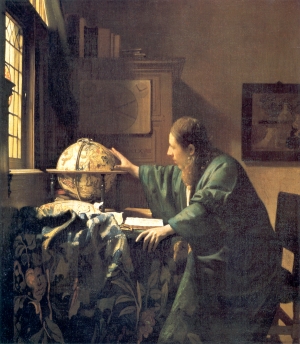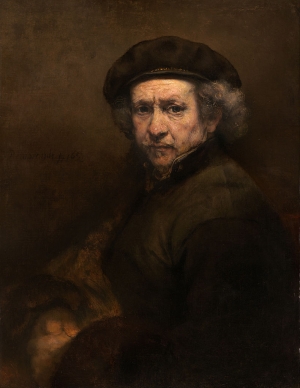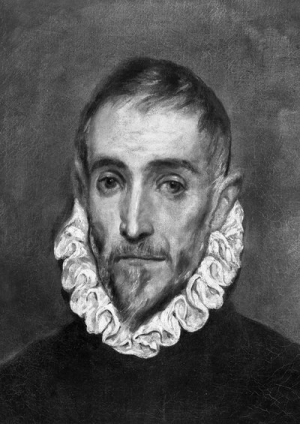|
Displaying items by tag: dutch paintings
Since the late 1960s, art historians have known that another painting lay underneath Rembrandt’s famous An Old Man in Military Costume (painted about 1630-1631), a compelling character study (tronie) of age and one of the J. Paul Getty Museum’s most beloved Dutch paintings. Until now, however, seeing that hidden image in detail has been frustratingly elusive.
A recent collaborative study conducted by experts from Los Angeles, Antwerp, and Delft, using two complementary, element-specific imaging techniques, has provided the most detailed representation of the underlying painting—an image of a young man wrapped in a cloak—to date.

The Museum of Fine Arts, Boston, has announced loans of important paintings by Johannes Vermeer and Rembrandt van Rijn for its upcoming landmark exhibition "Class Distinctions: Dutch Painting in the Age of Rembrandt and Vermeer" (October 11, 2015–January 18, 2016). Vermeer’s "The Astronomer" (1668) will be on loan from the Musée du Louvre in Paris, while the artist’s "A Lady Writing" (about 1665) will be on loan from the National Gallery of Art in Washington, DC. Works by Rembrandt in the exhibition will include "The Shipbuilder and his Wife" (1633) on loan from Her Majesty Queen Elizabeth II and the full-length, life-size "Portrait of Andries de Graeff" (1639) from Museumslandschaft Hessen Kassel in Germany. They will join the two seated full-length portraits by Rembrandt from the MFA’s collection, "Reverend Johannes Elison" and "Maria Bockenolle" (both 1634).
"A Lady Writing" portrays a privileged woman engaged in the art of letter writing, associated in 17th-century Holland with a certain level of education and wealth. Belonging to the same elite world, "The Astronomer" represents a “gentleman amateur” engaged in scientific inquiry that had relevance to the maritime navigation crucial to the mercantile interests of the young country.

Thanks to a new film based on the critically acclaimed exhibition "Rembrandt: The Late Works" that debuted at the National Gallery, London, and opens at the Rijksmuseum, Amsterdam, on February 12, U.S. audiences will be able to experience the exhibition on screen. For one night only, on February 24, the new film "Rembrandt from the National Gallery London and Rijksmuseum Amsterdam" will be presented at over 300 movie theaters across the country.The film gives viewers an opportunity to see the once-in-a-lifetime installations of Rembrandt's paintings, prints, and drawings in these two preeminent institutions and learn more about the revered Dutch artist from scholars, curators, and art historians. Given exclusive access by both museums, the film documents this extraordinary presentation and interweaves Rembrandt's life story with the preparations at both institutions.
Betsy Wieseman, Curator of Dutch and Flemish Paintings, National Gallery, and Jonathan Bikker, Curator of Research at the Rijksmuseum, among others, provide illuminating context regarding Rembrandt's life and times.
The latest exhibit at the Bruce Museum being Northern Baroque art to Greenwich, all the way from Vienna.
"They are lent to us throughout the great generosity of Prince Liechtenstein because they are on permanent loan to the Princely Collections of Liechtenstein in Vienna in the Great Palace. They range in date from the late 16th Century to the early 19th Century. Most are Dutch and Flemish paintings of the 17th Century. There's also some very fine German 17th Century pictures too," said Peter Sutton, the Executive Director of the Bruce Museum.
Sutton is an expert on this art and gave a tour of the 64 paintings on display.

The Frick’s Center for the History of Collecting announces a new book series with the publication of its first volume, "Holland’s Golden Age in America: Collecting the Art of Rembrandt, Vermeer, and Hals." This series, entitled The Frick Collection Studies in the History of Collecting, is co-published with the Pennsylvania State University Press, and will ultimately cover a broad range of art collecting, reflecting the Center's reach well beyond the parameters of the Frick's own scope to include topics on modern and non-western art. Comments Inge Reist, Director of the Center, “We aim to encourage new scholarship in this young field of art history through our annual acclaimed symposia and ongoing fellowship program, much of which leads to new publications. Complementing that activity is this series that enables the Center to make its own contribution to the growing bibliography on the history of collecting in America.” This and future volumes are drawn from papers given at the Center’s symposia. Upcoming books from recent events include "A Market for Merchant Princes: Collecting Italian Renaissance Painting in America" (February 2015), edited by Inge Reist; "Going for Baroque: Americans Collect Italian Paintings of the 17th and 18th Centuries," edited by Edgar Peters Bowron; and "The Americas Revealed: Collecting Colonial and Modern Latin American Art in the United States," edited by Edward Sullivan.
Americans have long had an interest in the art and culture of Holland’s Golden Age. As a result, the United States can boast extraordinary holdings of Dutch paintings. Celebrated masters such as Rembrandt, Johannes Vermeer, and Frans Hals are exceptionally well represented in museums and private collections, but many fine paintings by their contemporaries can be found here as well.

The Frick Collection in New York is the final venue of an American tour of paintings from the Dutch museum the Royal Picture Gallery Mauritshuis. Vermeer, Rembrandt, and Hals: Masterpieces of Dutch Painting from the Mauritshuis includes fifteen of the museum’s most import works, hand-picked especially for the Frick. Together, the paintings represent the remarkable achievements of northern artists in the 19th century. Works by Rembrandt, Frans Hals, Jan Steen, Jacob van Ruisdael will be on view as well as Johannes Vermeer’s seminal painting Girl with a Pearl Earring, which has not been displayed in New York since 1984.
While the Mauritshuis is undergoing a two-year renovation, it is lending masterpieces that have not traveled in nearly thirty years. The exhibition at the Frick is accompanied by a catalogue and a series of public programs. It will also include select evening hours.
Vermeer, Rembrandt, and Hals: Masterpieces of Dutch Painting from the Mauritshuis will be on view at the Frick Collection through January 19, 2014.
On May 23, 2013, after a two and a half year renovation, the Metropolitan Museum of Art in New York will unveil 45 updated and expanded galleries of European paintings. The new space, which has increased by about a third, boasts 600 works of art dating from 1250 to 1800. Arranged in chronological order and grouped by country, the collection includes the Met’s renowned holdings of early Dutch, French, and Italian paintings.
The reimagined European painting galleries include 23 high profile loans, mainly from private collections. Works by Jan Van Eyck (1395-1441), Nicolas Poussin (1594-1665), Sandro Botticelli (1445-1510), and Peter Paul Rubens (1577-1640) will be on view for at least six months thanks to the generosity of the Met’s trustees, and patrons.
The Met’s European painting galleries have not been fully renovated since the early 1950s. When the new galleries open next week, the Met will offer various walking guides as well as online versions of the tours.

In 1932, Colonel Michael Friedsam, president of the New York City-based department store, B. Altman, bequeathed a huge portion of his estate to the Brooklyn Museum. It recently came to light that nearly a quarter of the 926 gifted works were fakes, misattributions or lacking in terms of quality. The Brooklyn Museum must now come up with a plan for the 229 pieces it no longer wants, which range from Dutch and Renaissance paintings to Chinese porcelains, jewelry, and furniture.
The museum is unable to sell the works for even the smallest profit because Colonel Friedsman’s will contains a clause stating that the museum must gain permission from the estate’s executor before deaccessioning works. Unfortunately, the last executor of Friedsman’s estate passed away in 1962. The Brooklyn Museum is currently working with the New York State attorney general’s office to maneuver around the clause. However, another clause in Friedsman’s will is proving problematic as it states that if the collection is broken up, the works should go to his brother-in-law and two friends. The museum has not yet started looking for the descendants of these three individuals as they are still working with the attorney general’s office to decide how to proceed.
The unwanted works are becoming more difficult to deal with, as the Brooklyn Museum is short on storage space. If the institution is unable to relieve itself of some of these works, they will be forced to rent additional storage spaces, which could cost the museum hundreds of thousands of dollars.
|
|
|
|
|